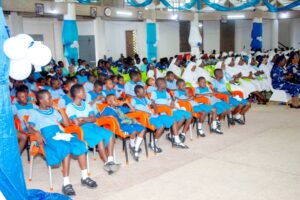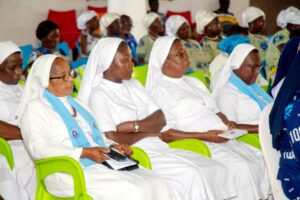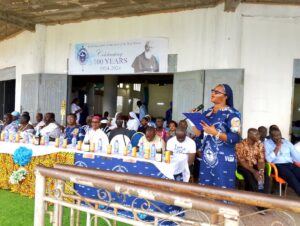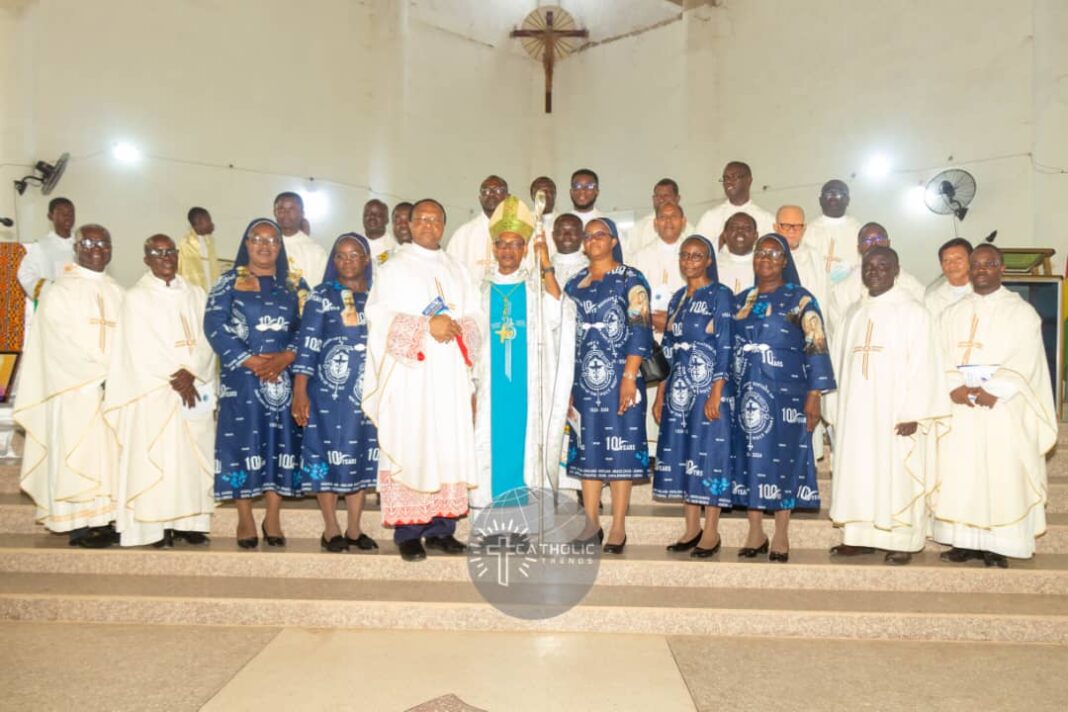As part of the climax celebration of the centenary of its foundation, the Missionary Sisters of our Lady of the Holy Rosary (MSHR), Ghana launched a book titled the “Centenary Blossoms” which seeks to capture the narrative of the principal events in the life of the Congregation over the past one hundred years.
Other activities Renewal of Vows by the Sisters, appeal for funds to expand the Sisters’ Chapel at Donkorkrom, welcome song by the Parish Vocation Group, Cultural display by the learners of Holy Rosary School, among others.
The main celebration of the Centenary had been preceded by free health screening in the Donkorkrom and Amankwakrom Communities, where the Sisters live and work, as well as a friendly football match between the staff of Holy Rosary Health Centre, Amankwakrom and motorbike riders of same community, all organized by the Ghana Region Holy Rosary Sisters, to sensitize the community on the upcoming 5th October event.
It happened that the MSHR Centenary Celebration in Ghana coincided with that of two other Regions: the USA and Southern Nigeria Region who had a threefold grand finale: First Profession of 6 Novices from various countries, Perpetual Vows of 2 Sisters and Silver Jubilee celebrations of 2 Sisters. The Celebration at the Congregational level had taken place in Ireland during the last Chapter of Elections from July to August this year.
Still as part of the Centenary Celebration, some 15 members from across the congregation, including Sr. Franca Onyibor, MSHR, Congregational Leader and her Council were privileged to have papal audience with the Holy Father at the Vatican last month.
The congregation of the Missionary Sisters of our lady of the Most Holy Rosary (MSHR) was founded at Drumully House Killeshandra, Co. Cavan, Ireland on March 7, 1924 by Bishop Joseph Ignatius Shanahan, CSSp, then Apostolic Vicar of Southern Nigeria.
Seven postulants entered that day, three of whom (among others) had been lay missionaries with Bishop Shanahan between the years 1921 and 1924 at St Joseph’s Girls’ School Calabar, Nigeria (the only girl’s primary school in that vast area of the Vicariate).
Prior to Foundation Day, Bishop Shanahan had encountered a number of challenges in bringing the Congregation to birth.
In 1921, he wrote an article in which he spelt out the need for women missionaries for without them, the young girl and the wife are inevitably neglected.
He failed, however, despite many years of effort to secure any Irish Congregation of Sisters to go to Nigeria to assist in the evangelization and education of women. Secondly, his request to secure a base for the proposed missionary Congregation in a diocese in Ireland was declined by a number of Bishops.
However, a chance but unexpected encounter with Bishop P Finnegan of Kilmore on 2 October 1923 resulted in an invitation to establish the proposed Congregation in the Diocese of Kilmore.
Upon receiving this good news, Bishop Shanahan lost no time and he immediately set about to look for a property for the proposed convent. Having surveyed and sought advice about three properties in and around Cavan he purchased Drumully (Drum Mullach) House and land just outside the town of Killeshandra on 20 November 1923.
Bishop Shanahan recalled to Ireland Fr. P J Whitney, Diocese of Ardagh and Clonmacnoise, (later Founder of St Patrick’s Missionary Society) who was one of the first Irish Diocesan priests to volunteer in 1920 for ministry in Nigeria, to begin fundraising in Ireland for the new Congregation.
This was an essential move on Bishop Shanahan’s part as he was bereft of any funds and had to obtain a bank loan in order to buy Drumully House. Prior to the purchase of Drummully House, eight women who were interested in becoming members of the proposed Congregation had earlier gathered from the beginning of October 1923 at the Dominican Convent Cabra, Dublin.

The Dominican Sisters at Cabra had acceded to Bishop Shanahan’s request to undertake the formation and training of the proposed members. The Dominican Sisters remained with the fledging congregation for ten years until the Congregation became self-governing in 1934.
From the first seven postulants in 1924, the Congregation grew rapidly in membership during the following years and by the end of the foundation Decade in 1934 there were fifty-nine professed Sisters, fifteen of whom were on mission in Nigeria.
In the ensuing ninety years, the Congregation continued to grow in membership while geographically expanding into fifteen mission territories in Africa and the Americas; Nigeria (1928), England (1939) South Africa (1940), Sierra Leone (1948), USA (1952), Cameroon (1956). Kenya (1956), Benue, Nigeria (1957), Zambia (1963), Brazil 1966). Scotland (1973), Ghana (1975), Ethiopia (1975), Mexico (1992), and Liberia (2006).

As the twentieth century was drawing to a close, the demographic profile of the Congregation was changing. From 1970 onwards membership declined but became more diversified. Vocations decreased in the western world while vocations in Africa increased.
At present new members come predominantly from those African countries perceived as mission countries’ one hundred years ago. The novitiate of the Congregation is in Southern Nigeria while Candidacy is established in both Cameroon and Kenya.
Young women from West Africa (Nigeria, Cameroon, Ghana, Benin Republic, Togo and Sierra Leone) and East Africa (Kenya, Zambia, Ethiopia. Uganda) are trained as Holy Rosary Sisters and missioned to various administrative regions of the Congregation.

Up to 1970 the focus of the Congregation’s service was primarily directed to institutional needs in the emerging African nations – formal education at all levels, healthcare in all its dimensions, social development and pastoral care.
Today Sisters continue to be involved in those services but are also engaged with people of diverse faiths in responding to challenges and needs of the twenty-first century; defence of human rights, justice and peace issues, inter-religious dialogue, ecology and care of the earth, support of refugees, migrants and minorities.
By Sr. Sylvie Lum Cho, MSHR (Sister Communicator)



